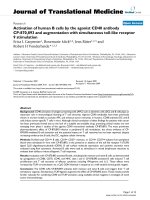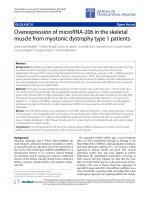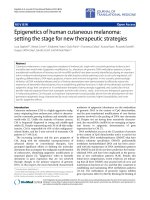báo cáo hóa học:" Rupture of the ilio-psoas tendon after a total hip arthroplasty: an unusual cause of radio-lucency of the lesser trochanter simulating a malignancy" pot
Bạn đang xem bản rút gọn của tài liệu. Xem và tải ngay bản đầy đủ của tài liệu tại đây (1.25 MB, 5 trang )
CAS E REP O R T Open Access
Rupture of the ilio-psoas tendon after a total hip
arthroplasty: an unusual cause of radio-lucency of
the lesser trochanter simulating a malignancy
Aditya V Maheshwari
1*†
, Rajesh Malhotra
2†
, Deepak Kumar
3†
, J David Pitcher Jr
1†
Abstract
Avulsion fracture or progressive radiolucency of lesser trochanter is considered a pathognomic finding in patients
with malignancies. Although surgical release of the iliopsoas tendon may be required during a total hip arthro-
plasty (THA), there is no literature on spontaneous rupture of the ilio-psoas tendon after a THA causing significant
functional impairment. We report here such a case, which developed progressive radiolucency of the lesser tro-
chanter over six years after a THA, simulating a malignancy. The diagnosis was confirmed by MRI. Because of the
chronic nature of the lesion, gross retraction of the tendon into the pelvis, and low demand of our patient, he was
treated by physiotherapy and gait training. Injury to the ilio-psoas tendon can occur in various steps of the THA
and extreme care should be taken to avoid this injury. Prevention during surgery is better, although there are no
reports of repair in the THA setting. This condition shoul d be considered in patients who present with progressive
radioluceny of the lesser trochanter, especially in the setting of a hip/pelvic surgery. Awareness and earlier recogni-
tion of the signs and symptoms of this condition will aid in diagnosis and will direct appropriate management.
Introduction
Avulsion fracture of lesser trochanter of the femur is a
well known entity in children and adolescents [1]. How-
ever, its fracture or progressive radiolucency is consid-
ered a pathognomic findi ng in adults with malignancies
[2]. Spontaneous rupture of ilio-psoas tendon is rare
and has not been described before in the setting of a
total hip arthroplasty (THA). We present here such a
case who had a spontaneous rupture of the ilio-psoas
tendon few days after a THA with subsequent progres-
sive radiolucency of the lesser trochanter, simulating a
malignancy. Awareness of this entity would aid in the
diagnosis, prevent confusion with malignant disease, and
allow appropriate management along with patient
reassurance.
Case report
A 77-year old, otherwise healthy, sedentary male was
referredtotheorthopediconcologyservicefora
progressive radiolucency of the lesser trochanter on
radiographs (Fig. 1). He had undergone a hybrid THA
for degenerative right hip disease at another institute six
years ago but had persistent groin pain after the surgery.
During a physiotherapy session at two weeks postopera-
tively, he felt a sudden increase in groin pain and then a
‘pop’ while negotiating stairs, and was not able to ambu-
late independently after that. He stopped his therapy
and did not see his primary surgeon f or the next six
weeks. He was then prescribed further therapy which he
did not comply and thereafter had been using an assis-
tive device all the time. His pain gradually improved but
he had been having persistent difficulty and weakness
while walking on uneven surface, getting in and out of
car , getting in a nd out of bed and negotiating stairs. He
denied any prolonged medication or any prior injection
in his hip.
On examination, he ambulated with a single crutch.
Active straight leg raise was not sustainable. Seated hip
flexion was graded as 3/5. There was no tenderness or
palpable mass in the groin. Distal neuro-vascular status
wasintact.Theprevioussurgeonsdidnotrecallany
intraoperative complication or surgical release of ilio-
psoas tendon. Radiographs were not suggestive of
* Correspondence:
† Contributed equally
1
Musculoskeletal Oncology, Department of Orthopaedics, University of Miami
Miller School of Medicine, 1400 NW 12th Ave University of Miami Hospital,
East Building, #4036 Miami, FL 33136, USA
Maheshwari et al. Journal of Orthopaedic Surgery and Research 2010, 5:6
/>© 2010 Maheshwari et al; licensee BioMed Central Ltd. This is an Open Access article distributed under the terms of the Creative
Commons Attribution License ( ), whic h permits unrestricted use, distribution, and
reproduction in any medium, provided the original work is properly cited.
implant loosening, malpositioning, osteolysis or wear.
Although radiolucency is common in Gruen Zones 7
and 14 after cemented THA [3], it was progressive in
this case as compared to previous radiographs and the
contralateral side. A Magnetic Resonance Imaging
(MRI) showed no lesion in or around the lesser trochan-
ter. Instead it revealed a chronic ruptured ilio-psoas ten-
don with retraction into the pelvis without residual
tendon on the lesser trochanter (Figs. 2 and 3). Labora-
tory work-up was uneventful. A diagnosis of chronic
ilio-psoas tendon rupture with disuse osteopenia of les-
ser trochanter was made.
Because of the chronic nature of the lesion, gross
retraction of the tendon into the pelvis, and low demand
of our patient, he was treated by physiotherapy and gait
training. At four years follow-up and almost 10 years
after his THA, he still uses a cane for outdoor ambula-
tion. Otherwise his medical history has been uneventful
with no evidence of any malignancy.
Discussion
The differential diagnosis of groin pain after a THA
includes sepsis, aseptic loosening of components, wear
and osteolysis, heterotopic ossification, fracture, neuro-
logic, vascular or abdominal pathology, referred pain
from th e spine or knee, as well soft tissue irritation such
as ilio-psoas tendonitis and synovitis [4-8]. Although
ilio-psoas tendonitis has been described in sports
medicine and radiology literature [9-12], it is now been
increasingly recognized and reported as a cause of groin
pain after a THA [4-8]. The incidence of ilio-psoas ten-
donitis has been reported as high as 4.3% (9 of 206
THAs) [8]. However, postoperative rupture of the ilio-
psoas tendon after a THA causing significant functional
impairment has not been documented before. Moreover,
the progressive radiolucency of the greater trochanter
due to disuse raised a suspicion of an underlying malig-
nant process.
Pain specific to ilio-psoas irritation include activities
like straight leg raise and resisted hip flexion, passive
hyperextension and manifest in day to day life as
ascending stairs, lifting the operative leg into the bed,
lifting the leg in and out of the car (requiring use of a
hand for support) and walking on uneven surface [4-8].
This differentiates it from component loosening, which
can cause pain with any weight bearing. The cause has
been linked to irritation of the tendon due an anteriorly
protruded cup, in cases of a lateralized, oversized or ret-
roverted cup, especially with capsulectomy, protruding
screws in the pelvic cavity, overhanging and protruding
cement, and also in cases with limb lengthening or an
increase in the offset. Although a local anesthetic injec-
tion may provide temporary relief and aid in diagnosis,
release of the ilio-psoas tendon has been consistently
shown to alleviate the symptoms, but component revi-
sion may be required in some cases.
Figure 1 AP and lateral views of the right hip showing a well fixed hybrid implants with a radio-lucency around the lesser trochanter
region (arrows), suggesting disuse atrophy in retrospective.
Maheshwari et al. Journal of Orthopaedic Surgery and Research 2010, 5:6
/>Page 2 of 5
An acute rupture of the tendon may manifest as pain
in the groin with exacerbation with both flexion and
extension of th e hip. A palpable mass along with ecchy-
mosis may be present [11]. In earlier setting, an utra-
sound can demonstrate bursitis, tendonitis or snapping
of the tendon over the overhanging acetabulum margin
[12]. Apart from showing the soft tissue swelling, a
Computed Tomography is also h elpful to rule out com-
ponent malpositiong [6,7]. Although MRI is the most
sensitive study to assess the tendon, its role in a THA
setting has been traditionally limited due to the artifact
generated by metallic implants. However, with modifica-
tion of pulse sequence with the help of commercially
available software, MRI is emerging as an effective tool
for assessment of periprosthetic soft tissues, osteolysis
and particle disease [13,14]. Axial MR provide the most
usef ul images for diagnosis and in acute cases will show
proximal muscle swelling and edema, thickening and
Figure 2 A coronal T1 MRI showing a normal ilio-psoas tendon on the left side (arrows) but its absence on the right side.
Figure 3 An axial T2 MRI showing the fatty atrophy and retraction of the right ilio-psoas tendon (arrow) all the way to the level of
the sacro-iliac joint.
Maheshwari et al. Journal of Orthopaedic Surgery and Research 2010, 5:6
/>Page 3 of 5
interruption of the tendon with an otherwise empty
fluid-filled distal tendon sheath [11]. Chronic cases will
show muscle atrophy with fatty degeneration.
Although no CT was obtained in our case, radio-
graphs did not show any component malpositioning.
Ilio-psoastendonitishasbeenshowneveninthe
absence of impingement [7]. However the presence of
persistin g groin pain with an acute rupture during ther-
apy (loading of the tendon) does indicate a peri-opera-
tive injury to the tendon. The ilio-psoas tendon may be
injuredatthetimeofexposure,atthetimeofdisloca-
tion, at the time of neck osteotomy, or even at the time
of femoral preparation. Moreover, we still d o not know
the effect of local steroid injection in the tendon as
these injections are commonly used peroperatively for
postoperative pain management.
There is only o ne more report of spontaneous atrau-
matic rupture of distal ilio-psoas tendon in two patient s
(without arthroplasty); however their medical history
was complicated by rheumatoid arthritis, diffuse non-
myelinating polyneuropathy, Parkinsonism, V itamin B-
12 deficiency, osteoporosis and Alzheimer’s disease [11].
Iliacus muscle injury and resulting hematoma causing
femoral nerve palsy has also been described after
abdominal extension exercise s [15], and also a fter both
cemented and cementless THA, where medial wall has
been perforated, especially in patients on anticoagulation
therapy [16-19].
Conclusion
In conclusion, we report a rare instance of rupture of
the ilio-psoas tendon after a THA. This condition
should be considered in patients who presen t with pro-
gressive radioluceny of the lesser trochanter, especially
in the setting of a hip/pelvic surgery. Although weakness
of hip flexion has not been reported after tenotomy for
ilio-psoas impingement [5,6], our patient had significant
functional disability. This may be due to chronic unrec-
ognized t ear and lack of physical therapy to train other
muscles for hip flexion. Injury to the ilio-psoas tendon
can occur in various steps of the THA and extreme care
should be taken to avoid this injury. Prevention during
surgery is better, although there are no reports of repair
in the THA setting. Since ilio-psoas is a postero-medial
structure, repair through the most common postero-lat-
eral approach would be difficult because retraction
would occur to the medial aspect of the femur and into
the inguinal canal. Close postoperative follow-up by the
treating p hysician, and not solely relying on rehabilita-
tive care providers ma y have identified the rupture in a
more timely way. Awareness and earlier recognition of
the signs and symptoms of this condition will aid in
diagnosis and will direct appropriate management.
Consent
Written informed consent was obtained from the patient
for publication of this case report and the accompanying
images. A copy of the written consent is available for
review by the Editor-in-Chief of this journal.
Acknowledgements
Institution of study: Musculoskeletal Oncology, Department of Orthopaedics,
University of Miami Miller School of Medicine, Miami, FL, USA 33136
IRB: This report was exempted from IRB review as it was not considered
Human Subject Research under 45 CFR 46 as per University Of Miami
Human Subjects Research Office.
Author details
1
Musculoskeletal Oncology, Department of Orthopaedics, University of Miami
Miller School of Medicine, 1400 NW 12th Ave University of Miami Hospital,
East Building, #4036 Miami, FL 33136, USA.
2
All India Institute of Medical
Sciences, Ansari Nagar, New Delhi, 110029, India.
3
Department of
Biomechanics and Movement Science, University of Delaware, Newark, DE
19711, USA.
Authors’ contributions
JDP was the surgeon in charge of the patient described with in this report.
AVM, DK and RM conducted the literature review and analysed the gathered
reports for the described case. AVM, DK and RM composed and wrote the
manuscript. All authors read and approved the final manuscript.
Competing interests
The authors declare that they have no competing interests.
Received: 1 November 2009
Accepted: 5 February 2010 Published: 5 February 2010
References
1. Theologis TN, Epps H, Latz K, Cole WG: Isolated fractures of the lesser
trochanter in children. Injury 1997, 28:363-4.
2. Afra R, Boardman DL, Kabo JM, Eckardt JJ: Avulsion fracture of the lesser
trochanter as a result of a preliminary malignant tumor of bone. A
report of four cases. J Bone Joint Surg Br 1999, 81:1299-304.
3. Mulroy WF, Harris WH: Acetabular and femoral fixation 15 years after
cemented total hip surgery. Clin Orthop Relat Res 1997, 337:118-28.
4. Trousdale RT, Cabanela ME, Berry DJ: Anterior iliopsoas impingement after
total hip arthroplasty. J Arthroplasty 1995, 10:546-9.
5. Heaton K, Dorr LD: Surgical release of iliopsoas tendon for groin pain
after total hip arthroplasty. J Arthroplasty 2002, 17:779-81.
6. Dora C, Houweling M, Koch P, Sierra RJ: Iliopsoas impingement after total
hip replacement: the results of non-operative management, tenotomy
or acetabular revision. J Bone Joint Surg Br 2007, 89:1031-5.
7. Jasani V, Richards P, Wynn-Jones C: Pain related to the psoas muscle after
total hip replacement. J Bone Joint Surg Br 2002, 84:991-3.
8. Ala Eddine T, Remy F, Chantelot C, Giraud F, Migaud H, Duquennoy A:
Anterior iliopsoas impingement after total hip arthroplasty: diagnosis
and conservative treatment in 9 cases. Rev Chir Orthop Reparatrice Appar
Mot 2001, 87:815-9.
9. Johnston CA, Wiley JP, Lindsay DM, Wiseman DA: Iliopsoas bursitis and
tendinitis. A review. Sports Med 1998, 25:271-83.
10. Janzen DL, Partridge E, Logan PM, Connell DG, Duncan CP: The snapping
hip: clinical and imaging findings in transient subluxation of the
iliopsoas tendon. Can Assoc Radiol J 1996, 47:202-8.
11. Lecouvet FE, Demondion X, Leemrijse T, Berg Vande BC, Devogelaer JP,
Malghem J: Spontaneous rupture of the distal iliopsoas tendon: clinical
and imaging findings, with anatomic correlations. Eur Radiol 2005,
15:2341-6.
12. Rezig R, Copercini M, Montet X, Martinoli C, Bianchi S: Ultrasound
diagnosis of anterior iliopsoas impingement in total hip replacement.
Skeletal Radiol 2004, 33:112-6.
13. Potter HG, Foo LF: Magnetic resonance imaging of joint arthroplasty.
Orthop Clin North Am 2006, 37:361-73.
Maheshwari et al. Journal of Orthopaedic Surgery and Research 2010, 5:6
/>Page 4 of 5
14. Potter HG, Nestor BJ, Sofka CM, Ho ST, Peters LE, Salvati EA: Magnetic
resonance imaging after total hip arthroplasty: evaluation of
periprosthetic soft tissue. J Bone Joint Surg Am 2004, 86:1947-54.
15. Sanders SM, Schachter AK, Schweitzer M, Klein GR: Iliacus muscle rupture
with associated femoral nerve palsy after abdominal extension exercises:
a case report. Am J Sports Med 2006, 34:837-9.
16. Ha YC, Ahn IO, Jeong ST, Park HB, Koo KH: Iliacus hematoma and femoral
nerve palsy after revision hip arthroplasty: a case report. Clin Orthop
Relat Res 2001, 385:100-3.
17. Gogus A, Ozturk C, Sirvanci M, Aydogan M, Hamzaoglu A: Femoral nerve
palsy due to iliacus hematoma occurred after primary total hip
arthroplasty. Arch Orthop Trauma Surg 2008, 128:657-60.
18. Solheim LF, Hagen R: Femoral and sciatic neuropathies after total hip
arthroplasty. Acta Orthop Scand 1980, 51:531-4.
19. Wooten SL, McLaughlin RE: Iliacus hematoma and subsequent femoral
nerve palsy after penetration of the medical acetabular wall during total
hip arthroplasty. Report of a case. Clin Orthop Relat Res 1984, 191:221-3.
doi:10.1186/1749-799X-5-6
Cite this article as: Maheshwari et al.: Rupture of the ilio-psoas tendon
after a total hip arthroplasty: an unusual cause of radio-lucency of the
lesser trochanter simulating a malignancy. Journal of Orthopaedic Surgery
and Research 2010 5:6.
Submit your next manuscript to BioMed Central
and take full advantage of:
• Convenient online submission
• Thorough peer review
• No space constraints or color figure charges
• Immediate publication on acceptance
• Inclusion in PubMed, CAS, Scopus and Google Scholar
• Research which is freely available for redistribution
Submit your manuscript at
www.biomedcentral.com/submit
Maheshwari et al. Journal of Orthopaedic Surgery and Research 2010, 5:6
/>Page 5 of 5









